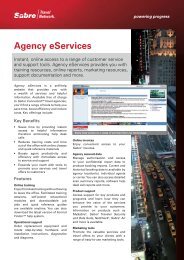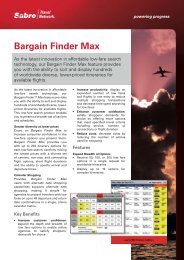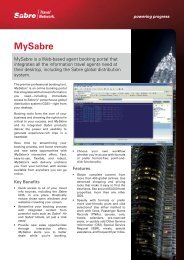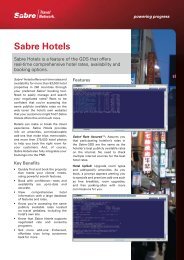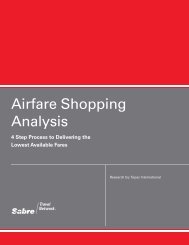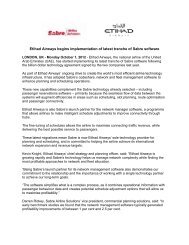Trends in Travel Agency Point-of-Sale Technology May 2009
Trends in Travel Agency Point-of-Sale Technology - Sabre Travel ...
Trends in Travel Agency Point-of-Sale Technology - Sabre Travel ...
- No tags were found...
You also want an ePaper? Increase the reach of your titles
YUMPU automatically turns print PDFs into web optimized ePapers that Google loves.
<strong>Trends</strong> <strong>in</strong> <strong>Travel</strong> <strong>Agency</strong> Po<strong>in</strong>t-<strong>of</strong>-<strong>Sale</strong> <strong>Technology</strong> <strong>May</strong> <strong>2009</strong><br />
Description<br />
Po<strong>in</strong>t-<strong>of</strong>-sale (POS) technology is an<br />
important part <strong>of</strong> a modern travel agency’s<br />
automation strategy. As the onl<strong>in</strong>e<br />
market evolves, travel management<br />
companies (TMCs) need to <strong>in</strong>tegrate Web<br />
and GDS content together <strong>in</strong> a seamless<br />
environment. The need to drive agency<br />
productivity and control po<strong>in</strong>t-<strong>of</strong>-sale<br />
errors is equally important as multi-source<br />
<strong>in</strong>tegration. This paper reviews trends<br />
<strong>in</strong> agency POS technology, compar<strong>in</strong>g<br />
<strong>in</strong>ternal development, third-party tools<br />
and global distribution system (GDS) POS<br />
solutions. It also provides a clear set <strong>of</strong><br />
recommendations on how large TMCs<br />
should approach a POS re-eng<strong>in</strong>eer<strong>in</strong>g<br />
effort.<br />
©<strong>2009</strong> PhoCusWright Inc. All Rights Reserved<br />
4
<strong>Trends</strong> <strong>in</strong> <strong>Travel</strong> <strong>Agency</strong> Po<strong>in</strong>t-<strong>of</strong>-<strong>Sale</strong> <strong>Technology</strong> <strong>May</strong> <strong>2009</strong><br />
Executive Summary<br />
The role <strong>of</strong> agent POS technology<br />
The call centre <strong>in</strong>terface plays a critical role<br />
<strong>in</strong> driv<strong>in</strong>g efficiency and standards across<br />
agency locations. TMCs need to both drive<br />
standardisation across global locations and<br />
customise the <strong>in</strong>terface to meet corporate<br />
clients’ specific requirements.<br />
Manag<strong>in</strong>g Web content<br />
The reality <strong>of</strong> today’s Web environment is<br />
that some <strong>in</strong>ventory or ancillary content will<br />
cont<strong>in</strong>ue to exist outside the standard GDS<br />
platform. Therefore, extraction tools must<br />
be constantly ma<strong>in</strong>ta<strong>in</strong>ed and updated to<br />
reflect changes <strong>in</strong> the Web site structure.<br />
Integrat<strong>in</strong>g Web content with standard<br />
GDS <strong>in</strong>ventory must be seamless and<br />
provide corporate customers with a s<strong>in</strong>gle<br />
<strong>in</strong>tegrated it<strong>in</strong>erary.<br />
Optimiz<strong>in</strong>g agent workflow<br />
The POS solution must optimise agent<br />
workflow while ensur<strong>in</strong>g that all required<br />
<strong>in</strong>formation is entered <strong>in</strong>to the PNR. It<br />
should also provide standardisation and<br />
customisation <strong>of</strong> the agent POS and<br />
optimise customer service.<br />
Up-front and ongo<strong>in</strong>g costs<br />
Internal development can be very costly<br />
and result <strong>in</strong> a solution that does not fully<br />
<strong>in</strong>tegrate with core GDS functionality. In<br />
particular, the cost <strong>of</strong> ma<strong>in</strong>tenance and<br />
enhancements can quickly sour return<br />
on <strong>in</strong>vestment <strong>of</strong> an <strong>in</strong>ternally developed<br />
solution.<br />
These tools have (and cont<strong>in</strong>ue to)<br />
evolve, address<strong>in</strong>g new bus<strong>in</strong>ess needs<br />
and emerg<strong>in</strong>g technology trends (e.g.,<br />
rich media, social network<strong>in</strong>g, flexible<br />
<strong>in</strong>tegration standards, unbundled services,<br />
telephone/email POS <strong>in</strong>teraction, etc.).<br />
Integration with po<strong>in</strong>t-<strong>of</strong>-sale<br />
extensions<br />
With a vast number <strong>of</strong> travellers expect<strong>in</strong>g<br />
seamless service across platforms (e.g.,<br />
mobile, onl<strong>in</strong>e/<strong>of</strong>fl<strong>in</strong>e symmetry), it is<br />
imperative that the po<strong>in</strong>t-<strong>of</strong>-sale <strong>in</strong>tegrate<br />
with multiple touch po<strong>in</strong>ts.<br />
Flexibility <strong>of</strong> platform for all types <strong>of</strong><br />
users<br />
The po<strong>in</strong>t-<strong>of</strong>-sale solution must be able<br />
to accommodate new agents as well as<br />
experienced agents who productively<br />
utilize the native GDS formats.<br />
Creat<strong>in</strong>g a cost-benefit analysis <strong>of</strong> POS<br />
options<br />
TMCs must do a thorough cost-benefit<br />
analysis when consider<strong>in</strong>g <strong>in</strong>ternally<br />
developed or third-party tools to ensure<br />
the <strong>in</strong>vestment matches the end results; the<br />
travel landscape is littered with the rema<strong>in</strong>s<br />
<strong>of</strong> unsuccessful attempts to develop POS<br />
applications <strong>in</strong>ternally and failed thirdparty<br />
solutions. GDS tools provide the best<br />
environment for the customisation and<br />
standardisation that ensure record accuracy<br />
and optimum customer service.<br />
The value <strong>of</strong> GDS tools<br />
There is a reason why over 83% <strong>of</strong> worldwide<br />
travel agents use the GDS. For years, GDS<br />
companies have focused on build<strong>in</strong>g the<br />
most efficient, productive distribution<br />
platform available to travel agents.<br />
©<strong>2009</strong> PhoCusWright Inc. All Rights Reserved<br />
5
<strong>Trends</strong> <strong>in</strong> <strong>Travel</strong> <strong>Agency</strong> Po<strong>in</strong>t-<strong>of</strong>-<strong>Sale</strong> <strong>Technology</strong> <strong>May</strong> <strong>2009</strong><br />
Introduction<br />
Despite the trend towards self-book<strong>in</strong>g, TMC<br />
call centre agents still handle the majority<br />
<strong>of</strong> travel reservations on a global basis.<br />
With the growth <strong>of</strong> low-cost carriers (LCCs)<br />
and unique Web content, travel agents must<br />
access multiple sources <strong>of</strong> <strong>in</strong>ventory. Agent<br />
productivity cont<strong>in</strong>ues to be a top priority<br />
for TMCs, particularly with the downward<br />
pressure on service fees. Should TMCs<br />
develop their own POS solutions to meet<br />
this multi-source challenge? Are third-party<br />
solutions the answer? What do the GDSs<br />
<strong>of</strong>fer to handle this new environment? This<br />
white paper will address current trends <strong>in</strong><br />
po<strong>in</strong>t-<strong>of</strong>-sale technology and review various<br />
options available for TMCs.<br />
©<strong>2009</strong> PhoCusWright Inc. All Rights Reserved<br />
6
<strong>Trends</strong> <strong>in</strong> <strong>Travel</strong> <strong>Agency</strong> Po<strong>in</strong>t-<strong>of</strong>-<strong>Sale</strong> <strong>Technology</strong> <strong>May</strong> <strong>2009</strong><br />
The Evolution <strong>of</strong> the <strong>Travel</strong> Agent Po<strong>in</strong>t-<strong>of</strong>-<strong>Sale</strong><br />
The Evolution <strong>of</strong> <strong>Travel</strong> Agent Po<strong>in</strong>t-<strong>of</strong>-<strong>Sale</strong><br />
Native<br />
GDS<br />
formats<br />
Script<strong>in</strong>g<br />
Webbased<br />
GDS<br />
access<br />
GDS plus<br />
Web<br />
content<br />
Figure 1<br />
©<strong>2009</strong> PhoCusWright Inc. All Rights Reserved<br />
The GDSs were built <strong>in</strong> the late 1960s,<br />
when broadband as we know it today did<br />
not exist. As a result, a special operat<strong>in</strong>g<br />
system was developed by IBM for the GDS,<br />
which broke the transaction <strong>in</strong>to small bits<br />
to accommodate this narrow bandwidth.<br />
The <strong>in</strong>terface to these systems required<br />
knowledge <strong>of</strong> specific, native GDS formats,<br />
and a corporate travel agent’s performance<br />
<strong>of</strong>ten was measured by his speed and<br />
knowledge <strong>of</strong> native GDS commands.<br />
This presented a challenge for agency<br />
management, who needed to balance agent<br />
productivity with customer service needs.<br />
Script<strong>in</strong>g soon emerged as an important<br />
productivity tool by comb<strong>in</strong><strong>in</strong>g multiple<br />
commands <strong>in</strong>to s<strong>in</strong>gle entries. With the<br />
growth <strong>of</strong> the Web <strong>in</strong> the late 1990s, GDSs<br />
changed their network <strong>in</strong>frastructure<br />
from dedicated leased telephone l<strong>in</strong>es<br />
to Internet-based protocols. This change<br />
created a more open platform, allow<strong>in</strong>g<br />
agents to access the Web as well as native<br />
GDS formats.<br />
The growth <strong>of</strong> the Internet also presented<br />
a new challenge as suppliers began to<br />
use the Web for more direct distribution.<br />
Fragmentation <strong>of</strong> supplier content, partially<br />
due to the growth <strong>of</strong> LCCs, required travel<br />
agents to efficiently shop, book, and service<br />
content from both the GDS and Web sources.<br />
However, a harmonious marriage between<br />
two fundamentally dist<strong>in</strong>ct content sources<br />
requires more than just a universal desktop<br />
application that displays content from both<br />
sources <strong>in</strong> one graphical screen.<br />
Third-party desktop tools<br />
Dur<strong>in</strong>g the 1990s and early 2000s, a number<br />
<strong>of</strong> third-party tools were <strong>in</strong>troduced to<br />
provide an alternative po<strong>in</strong>t-<strong>of</strong>-sale for<br />
the corporate travel agent. Independent<br />
s<strong>of</strong>tware providers found the market for<br />
travel agent POS tools to be both a great<br />
opportunity and a tremendous challenge.<br />
In some cases, these s<strong>of</strong>tware providers<br />
even had the back<strong>in</strong>g <strong>of</strong> mega-TMCs.<br />
But with the mergers and acquisitions<br />
that occurred <strong>in</strong> the late 1990s and early<br />
2000s, some providers lost their orig<strong>in</strong>al<br />
TMC sponsors, derail<strong>in</strong>g their efforts and<br />
prevent<strong>in</strong>g successful implementation. As<br />
native GDS formats changed, third-party<br />
solutions found it challeng<strong>in</strong>g to keep up<br />
with these modifications.<br />
For one th<strong>in</strong>g, agents tra<strong>in</strong>ed <strong>in</strong> (and<br />
accustomed to us<strong>in</strong>g) GDS native formats<br />
were more productive <strong>in</strong> these older formats<br />
than when us<strong>in</strong>g the new graphical user<br />
<strong>in</strong>terfaces (GUIs), which were unfamiliar. As<br />
Web content sources changed or emerged,<br />
these third-party tools could not keep<br />
up with the rate <strong>of</strong> change or provide the<br />
comparable response times and system<br />
stability that agents had come to expect<br />
from the GDS-provided po<strong>in</strong>ts-<strong>of</strong>-sale.<br />
Some <strong>of</strong> the larger TMCs developed their<br />
own POS tools, but these <strong>in</strong>ternal projects<br />
were costly, <strong>of</strong>ten requir<strong>in</strong>g millions <strong>of</strong><br />
dollars <strong>of</strong> <strong>in</strong>vestment and implementation<br />
cycles that took years to deploy.<br />
As a result, by the time the new platforms<br />
were completed, the pace <strong>of</strong> technological<br />
change <strong>of</strong>ten made them obsolete. For<br />
example, a Micros<strong>of</strong>t W<strong>in</strong>dows front-end<br />
was developed by one major TMC and by<br />
the time the application was completed,<br />
the technology had already shifted: Webbased<br />
front-ends had become the preferred<br />
development platform for enterprise<br />
applications, and this TMC was beh<strong>in</strong>d the<br />
times.<br />
7
<strong>Trends</strong> <strong>in</strong> <strong>Travel</strong> <strong>Agency</strong> Po<strong>in</strong>t-<strong>of</strong>-<strong>Sale</strong> <strong>Technology</strong> <strong>May</strong> <strong>2009</strong><br />
The emergence <strong>of</strong> GDS POS tools<br />
To respond to this chang<strong>in</strong>g market,<br />
GDS tools emerged that took advantage<br />
<strong>of</strong> the new Internet-based backbone by<br />
allow<strong>in</strong>g customisable platforms that<br />
used both native GDS formats and a GUI<br />
<strong>in</strong>terface. Dur<strong>in</strong>g the renegotiations <strong>of</strong><br />
airl<strong>in</strong>e agreements, the GDSs successfully<br />
persuaded ma<strong>in</strong>stream airl<strong>in</strong>es to provide<br />
full <strong>in</strong>ventory <strong>in</strong> their systems. As a result,<br />
despite lots <strong>of</strong> media hype around global<br />
distribution new entrants that reached<br />
a fever pitch back <strong>in</strong> 2005, today <strong>in</strong> <strong>2009</strong>,<br />
traditional GDSs have reta<strong>in</strong>ed the lion’s<br />
share <strong>of</strong> travel transactions.<br />
With the GDS passenger name record (PNR)<br />
still at the centre <strong>of</strong> the travel reservation<br />
process, TMCs must control the POS to<br />
ensure that all required fields are conta<strong>in</strong>ed<br />
<strong>in</strong> the PNR regardless <strong>of</strong> where <strong>in</strong> the world<br />
the reservation was booked. Customisation<br />
is also important, as different corporations<br />
or regions <strong>of</strong> the world <strong>of</strong>ten require<br />
different book<strong>in</strong>g flows (see Figure 2).<br />
Strik<strong>in</strong>g a balance between<br />
standardisation and customisation<br />
The ongo<strong>in</strong>g challenge to balance<br />
customisation and standardisation rema<strong>in</strong>s.<br />
Standardization is an important need <strong>in</strong><br />
today’s global competitive environment –<br />
mult<strong>in</strong>ational companies require consistent<br />
deployment <strong>of</strong> global policies.<br />
Standardisation vs. Customisation<br />
Standardisation:<br />
• Enforce mult<strong>in</strong>ational policies on a<br />
global basis<br />
• Ensure all required fields are<br />
conta<strong>in</strong>ed <strong>in</strong> the PNR<br />
• Achieve maximum productivity <strong>in</strong><br />
all regions<br />
• Control security-based access<br />
Customisation:<br />
• Meet specific book<strong>in</strong>g flow<br />
requirement <strong>of</strong> corporate clients or<br />
regional practices<br />
• Ensure optimum efficiency <strong>in</strong> a<br />
multi-source environment<br />
• Balance customer service<br />
capabilities with productivity goals<br />
Figure 2<br />
©<strong>2009</strong> PhoCusWright Inc. All Rights Reserved<br />
8
<strong>Trends</strong> <strong>in</strong> <strong>Travel</strong> <strong>Agency</strong> Po<strong>in</strong>t-<strong>of</strong>-<strong>Sale</strong> <strong>Technology</strong> <strong>May</strong> <strong>2009</strong><br />
Non-GDS Content<br />
By its very nature, the Internet is an<br />
open environment. As a result, there is<br />
potentially an endless amount <strong>of</strong> Webbased<br />
travel content, and bus<strong>in</strong>ess travel<br />
may have specific requirements depend<strong>in</strong>g<br />
on the journey. For example, alternate<br />
travel options such as rail or ferry services<br />
are common modes <strong>of</strong> transportation for<br />
bus<strong>in</strong>ess travel <strong>in</strong> specific global regions,<br />
and ancillary services such as limous<strong>in</strong>e<br />
or shuttle transfers can be common parts<br />
<strong>of</strong> the bus<strong>in</strong>ess travel process. The key<br />
decision is determ<strong>in</strong><strong>in</strong>g what Web content<br />
is critical, and how the po<strong>in</strong>t-<strong>of</strong>-sale best<br />
supports the <strong>in</strong>tegration <strong>of</strong> such data. The<br />
pursuit <strong>of</strong> a ground-up universal desktop<br />
is an expensive and most <strong>of</strong>ten fruitless<br />
avocation. In general, it <strong>of</strong>ten makes<br />
more sense to pursue solutions like Sabre<br />
NetCheck®, where Web content is brought<br />
<strong>in</strong> when required and is <strong>in</strong>tegrated <strong>in</strong>to the<br />
GDS core. More importantly, these tools<br />
provide the benefit <strong>of</strong> mak<strong>in</strong>g the book<strong>in</strong>g<br />
<strong>in</strong> the GDS whenever possible, thus<br />
help<strong>in</strong>g to preserve the agency’s efficiency,<br />
<strong>in</strong>centives and customer service.<br />
Integrat<strong>in</strong>g non-GDS content <strong>in</strong>to a<br />
GDS environment<br />
There are three ma<strong>in</strong> po<strong>in</strong>ts <strong>of</strong> <strong>in</strong>tegration<br />
to consider when br<strong>in</strong>g<strong>in</strong>g non-GDS content<br />
<strong>in</strong>to the GDS environment: GDS po<strong>in</strong>t-<strong>of</strong>sale<br />
<strong>in</strong>tegration (e.g., GDS native screen<br />
<strong>in</strong>teraction), post-book<strong>in</strong>g <strong>in</strong>tegration (e.g.,<br />
via automated quality control mechanisms)<br />
and enterprise content <strong>in</strong>tegration (e.g.,<br />
through a TMC or GDS content gateway).<br />
Integration at any <strong>of</strong> the above po<strong>in</strong>ts<br />
(POS, post-book<strong>in</strong>g, enterprise content<br />
gateway) usually boils down to a critical<br />
and common-sense trade-<strong>of</strong>f decision<br />
that must be understood at the outset. The<br />
table below illustrates the challenges and<br />
compromises to consider when evaluat<strong>in</strong>g<br />
the level <strong>of</strong> <strong>in</strong>tegration to pursue with non-<br />
GDS content:<br />
©<strong>2009</strong> PhoCusWright Inc. All Rights Reserved<br />
9
<strong>Trends</strong> <strong>in</strong> <strong>Travel</strong> <strong>Agency</strong> Po<strong>in</strong>t-<strong>of</strong>-<strong>Sale</strong> <strong>Technology</strong> <strong>May</strong> <strong>2009</strong><br />
Factors to Consider when Integrat<strong>in</strong>g Content<br />
Degree <strong>of</strong><br />
Integration<br />
Need<br />
Integration <strong>of</strong> a small number<br />
(1-2) non-GDS content sources,<br />
or a small amount (3-5) TMC /<br />
Corporation specific processes<br />
Integration <strong>of</strong> repeatable content<br />
or process checks (e.g. low fare<br />
SLA compliance checks, QC<br />
checks, etc.)<br />
Integration <strong>of</strong> critical non-GDS<br />
content from multiple suppliers,<br />
<strong>in</strong>tegrated with<strong>in</strong> agent workflow<br />
and seamless with overall TMC<br />
operations<br />
Deployment Scope<br />
Deployed to a few number <strong>of</strong><br />
agency locations desktops <strong>in</strong> one<br />
geographic location<br />
Deployed to multiple locations,<br />
multiple regions <strong>in</strong> a few<br />
geographic locations<br />
Deployed to numerous agent<br />
desktops, possibly across multiple<br />
geographic locations<br />
Cost, Time and Skills<br />
Consideration<br />
Low up-front cost, fast time to<br />
market (1-2 months)<br />
Medium up-front cost, quick time<br />
to market (2-3 months)<br />
Robust solution with longer time<br />
to market (3-9 months)<br />
Low required pr<strong>of</strong>iciency <strong>of</strong><br />
developers<br />
Medium level <strong>of</strong> pr<strong>of</strong>iciency<br />
required by developers<br />
High pr<strong>of</strong>iciency developers<br />
required<br />
Ma<strong>in</strong>ly a tactical <strong>in</strong>vestment.<br />
Low will<strong>in</strong>gness to cont<strong>in</strong>ually<br />
<strong>in</strong>vest for ma<strong>in</strong>tenance and<br />
enhancements<br />
Cont<strong>in</strong>ual <strong>in</strong>vestments are<br />
acceptable for quick to market<br />
enhancements only<br />
Tactical or strategic <strong>in</strong>vestment<br />
Cont<strong>in</strong>ual <strong>in</strong>vestments are viewed<br />
as strategic<br />
Best Po<strong>in</strong>t <strong>of</strong><br />
Integration<br />
Integration at the Po<strong>in</strong>t-<strong>of</strong>-<strong>Sale</strong><br />
For Content - Integrate at the<br />
POS. (e.g. FareWatcher alerts<br />
for non-GDS content from 1or 2<br />
suppliers)<br />
For Processes - Use scripts or<br />
po<strong>in</strong>t-<strong>of</strong>-sale APIs<br />
Integration Post-Book<strong>in</strong>g<br />
Integration <strong>of</strong> this type is<br />
best accomplished through<br />
centralized automation that<br />
applies repeatable processes with<br />
m<strong>in</strong>imal human <strong>in</strong>tervention<br />
Enterprise Content Gateway<br />
Through a GDS or TMC developed<br />
enterprise content gateway (e.g.<br />
Sabre NetCheck uses Sabre Web<br />
Services via a content gateway<br />
from over 80 non-GDS suppliers<br />
directly to agent desktops across<br />
the globe)<br />
Other Considerations<br />
• Bandwidth<br />
• Desktop hardware requirements<br />
• Browser compatibility<br />
• Firewall issues<br />
• Deploy<strong>in</strong>g the solution to all<br />
desktops<br />
• Security<br />
• Ma<strong>in</strong>tenance and enhancements<br />
• Test<strong>in</strong>g <strong>of</strong> QC / Mid-<strong>of</strong>fice tool<br />
to ensure all scenarios are<br />
covered<br />
• Exception handl<strong>in</strong>g <strong>of</strong>ten<br />
requires some agent re-touch<br />
<strong>of</strong> PNRs<br />
• Easy to enhance<br />
Global security and deployment<br />
Customer service and support for<br />
non-GDS book<strong>in</strong>gs<br />
Figure 3<br />
©<strong>2009</strong> PhoCusWright Inc. All Rights Reserved<br />
10
<strong>Trends</strong> <strong>in</strong> <strong>Travel</strong> <strong>Agency</strong> Po<strong>in</strong>t-<strong>of</strong>-<strong>Sale</strong> <strong>Technology</strong> <strong>May</strong> <strong>2009</strong><br />
As with any technology <strong>in</strong>vestment, this<br />
decision essentially <strong>in</strong>volves a trade-<strong>of</strong>f<br />
between speed, quality, and cost.<br />
Integration at the POS<br />
Comparatively, <strong>in</strong>tegration at the po<strong>in</strong>t<strong>of</strong>-sale<br />
has a faster time to market, is not<br />
seamless and has a cheaper up-front cost,<br />
but it requires more <strong>in</strong>vestment <strong>in</strong> ongo<strong>in</strong>g<br />
support and ma<strong>in</strong>tenance.<br />
Integration post-book<strong>in</strong>g<br />
Post-book<strong>in</strong>g <strong>in</strong>tegration is slower to get<br />
to market and more seamless. It is not as<br />
cheap as POS <strong>in</strong>tegration, as it typically<br />
<strong>in</strong>volves transactional third-party costs.<br />
Enterprise content gateways<br />
This k<strong>in</strong>d <strong>of</strong> <strong>in</strong>tegration <strong>in</strong>creases the time<br />
to market, but it is the most seamless. It<br />
is also expensive – a strategic <strong>in</strong>vestment<br />
with high up-front and operational costs,<br />
best delivered by global travel technology<br />
companies capable <strong>of</strong> handl<strong>in</strong>g complex<br />
projects.<br />
Additional considerations when<br />
<strong>in</strong>tegrat<strong>in</strong>g Web content at the POS<br />
Another important consideration for the<br />
multi-source environment is the consistent<br />
enforcement <strong>of</strong> a company’s travel policy.<br />
This is particularly important dur<strong>in</strong>g<br />
economic downturns, when corporations<br />
seek to reduce travel expenses. For<br />
example, dur<strong>in</strong>g difficult economic times,<br />
many companies shift from bus<strong>in</strong>ess<br />
class to economy for <strong>in</strong>ternational travel.<br />
Companies may opt for nonrefundable<br />
rather than higher, unrestricted fares. These<br />
policy changes must be uniformly enforced<br />
at all global locations.<br />
Of equal importance is data quality. The<br />
GDS PNR conta<strong>in</strong>s specific fields that<br />
correspond to departmental expense<br />
allocation. In addition, certa<strong>in</strong> corporate<br />
clients may require specific UDIDs (User<br />
Def<strong>in</strong>able Interface Data), l<strong>in</strong>es <strong>in</strong> the PNR<br />
that conta<strong>in</strong> specific pieces <strong>of</strong> <strong>in</strong>formation<br />
used for report<strong>in</strong>g purposes. Despite the<br />
hype about the need for a “super PNR”<br />
that exists outside the GDS, the reality <strong>of</strong><br />
today’s marketplace is that the GDS PNR<br />
is still the foundation for the majority<br />
<strong>of</strong> travel reservations. As a result, TMCs<br />
must <strong>in</strong>tegrate Web content with the<br />
GDS platform to ma<strong>in</strong>ta<strong>in</strong> control <strong>of</strong> the<br />
reservation while captur<strong>in</strong>g all elements<br />
<strong>of</strong> the bus<strong>in</strong>ess trip. To accomplish this, the<br />
POS solution must conta<strong>in</strong> a bus<strong>in</strong>ess rules<br />
layer to control access to non-GDS content.<br />
Even <strong>in</strong> an ideal environment, most non-<br />
GDS content requires the traveller (or travel<br />
arranger) to manage support services if<br />
the reservation is booked directly on the<br />
Web. For example, an LCC book<strong>in</strong>g would<br />
require the traveller to contact the airl<strong>in</strong>e<br />
for changes after ticket<strong>in</strong>g.<br />
These processes (<strong>in</strong>tegration, rule<br />
enforcement, and report<strong>in</strong>g) become<br />
<strong>in</strong>f<strong>in</strong>itely more complex <strong>in</strong> proportion to the<br />
number <strong>of</strong> Web content sources <strong>in</strong>tegrated<br />
with the desktop.<br />
©<strong>2009</strong> PhoCusWright Inc. All Rights Reserved<br />
11
<strong>Trends</strong> <strong>in</strong> <strong>Travel</strong> <strong>Agency</strong> Po<strong>in</strong>t-<strong>of</strong>-<strong>Sale</strong> <strong>Technology</strong> <strong>May</strong> <strong>2009</strong><br />
POS – The Key to Integrat<strong>in</strong>g Multiple Services <strong>in</strong> a S<strong>in</strong>gle Place<br />
It is critical that the agent po<strong>in</strong>t-<strong>of</strong>-sale<br />
<strong>in</strong>terface conta<strong>in</strong> essential <strong>in</strong>formation<br />
about the trip for a variety <strong>of</strong> reasons.<br />
These <strong>in</strong>clude:<br />
• Trip notification and schedule changes<br />
Airl<strong>in</strong>es frequently change schedules<br />
and flight numbers. To ensure that the<br />
record is accurate, the POS must <strong>in</strong>teract<br />
with these updates to reflect changes.<br />
• CRM and travel advisories<br />
To meet frequent travellers’ expectations,<br />
customer preferences must be applied<br />
to all elements <strong>of</strong> the reservation. <strong>Travel</strong><br />
advisories about specific dest<strong>in</strong>ations<br />
have to be applied to all elements <strong>of</strong> the<br />
traveller’s it<strong>in</strong>erary as well.<br />
• It<strong>in</strong>erary aggregation<br />
Bus<strong>in</strong>ess travellers expect all<br />
components <strong>of</strong> their it<strong>in</strong>erary to be<br />
available <strong>in</strong> a s<strong>in</strong>gle place, and agency<br />
POS tools must be able to capture all<br />
reservation <strong>in</strong>formation.<br />
• Invoic<strong>in</strong>g<br />
For proper bill<strong>in</strong>g purposes, the <strong>in</strong>voice<br />
must reflect all elements <strong>of</strong> the bus<strong>in</strong>ess<br />
travel it<strong>in</strong>erary.<br />
• Compar<strong>in</strong>g all supplier options<br />
One <strong>of</strong> the most important elements<br />
<strong>of</strong> any travel agent POS platform is the<br />
ability to aggregate and <strong>of</strong>fer all supplier<br />
options to the bus<strong>in</strong>ess traveller. This<br />
is at the heart <strong>of</strong> the need for a multisource<br />
platform, and is particularly<br />
relevant now that transparent pric<strong>in</strong>g is<br />
the norm <strong>in</strong> today’s Web environment.<br />
<strong>Travel</strong> options should also take <strong>in</strong>to<br />
account agency-preferred suppliers,<br />
corporate travel policies and/or traveller<br />
preferences dur<strong>in</strong>g the shopp<strong>in</strong>g<br />
process through bus<strong>in</strong>ess <strong>in</strong>telligence<br />
embedded with<strong>in</strong> the po<strong>in</strong>t-<strong>of</strong>-sale.<br />
• Track<strong>in</strong>g unused tickets<br />
Residual value <strong>of</strong>ten rema<strong>in</strong>s when<br />
tickets are refunded or exchanged.<br />
Track<strong>in</strong>g unused tickets and apply<strong>in</strong>g<br />
credit aga<strong>in</strong>st new it<strong>in</strong>eraries is an<br />
important feature needed <strong>in</strong> an agency<br />
POS solution. When us<strong>in</strong>g the residual<br />
value <strong>of</strong> the ticket, the POS system<br />
must accommodate all rules and be <strong>in</strong><br />
compliance with local BSP processes.<br />
• Captur<strong>in</strong>g accurate data for corporate<br />
report<strong>in</strong>g<br />
Inaccurate and <strong>in</strong>complete <strong>in</strong>formation<br />
<strong>in</strong> corporate report<strong>in</strong>g can <strong>of</strong>ten be<br />
traced directly to agent <strong>in</strong>put errors.<br />
The travel agent’s POS platform must<br />
prevent these errors from occurr<strong>in</strong>g<br />
so they are not ultimately reflected <strong>in</strong><br />
corporate report<strong>in</strong>g.<br />
©<strong>2009</strong> PhoCusWright Inc. All Rights Reserved<br />
12
<strong>Trends</strong> <strong>in</strong> <strong>Travel</strong> <strong>Agency</strong> Po<strong>in</strong>t-<strong>of</strong>-<strong>Sale</strong> <strong>Technology</strong> <strong>May</strong> <strong>2009</strong><br />
• Agent productivity<br />
At the heart <strong>of</strong> any POS solution is the<br />
impact on agent productivity. Three<br />
major areas need to be considered:<br />
• Tra<strong>in</strong><strong>in</strong>g issues <strong>of</strong> unique GUIs<br />
Any new <strong>in</strong>terface requires tra<strong>in</strong><strong>in</strong>g,<br />
and if the GUI is unique to the TMC,<br />
the cost <strong>of</strong> tra<strong>in</strong><strong>in</strong>g is a major factor<br />
to consider. Third-party or <strong>in</strong>ternally<br />
developed POS applications <strong>of</strong>ten<br />
require unique tra<strong>in</strong><strong>in</strong>g as well.<br />
• Accommodat<strong>in</strong>g older agents<br />
tra<strong>in</strong>ed on native GDS<br />
Traditional agents who have<br />
mastered native GDS formats <strong>of</strong>ten<br />
are far more productive than agents<br />
us<strong>in</strong>g a GUI. Any POS solution<br />
must accommodate these agents<br />
by blend<strong>in</strong>g native GDS capabilities<br />
with multi-source content.<br />
• GDS customisation available at<br />
agent’s POS<br />
Script<strong>in</strong>g has become a standard<br />
process for the majority <strong>of</strong> travel<br />
management firms. If the TMC is<br />
consider<strong>in</strong>g an <strong>in</strong>ternally developed<br />
or third-party solution, the value <strong>of</strong><br />
exist<strong>in</strong>g scripts may be lost.<br />
Overall, the goal <strong>of</strong> any POS<br />
implementation is to balance agent<br />
efficiency with customer service<br />
(see Figure 4).<br />
Workflow <strong>in</strong>tegration<br />
• Quality control (QC) at the<br />
po<strong>in</strong>t-<strong>of</strong>-sale<br />
A major trend <strong>in</strong> quality control<br />
systems is the ability to manage<br />
errors that happen at the agent<br />
POS. QC systems are generally<br />
provided by either third parties or<br />
the GDS. As a result, a TMC’s ability<br />
to implement a standard QC system<br />
at the POS may be impacted if<br />
the POS environment is <strong>in</strong>ternally<br />
developed or provided by a third<br />
party.<br />
• Adapt<strong>in</strong>g workflow to maximise<br />
agent’s roles<br />
TMC productivity is <strong>of</strong>ten improved<br />
by designat<strong>in</strong>g specific agents<br />
for specific tasks. Any POS<br />
solution must enable the efficient<br />
management <strong>of</strong> tasks based on an<br />
agent’s skill set or specific corporate<br />
account requirements.<br />
Balanc<strong>in</strong>g Efficiency with Customer Service<br />
Efficiency:<br />
• Accommodate experienced agents<br />
familiar with native GDS<br />
• Ensure that all required entries are<br />
<strong>in</strong> the PNR<br />
• Automate file f<strong>in</strong>ish<strong>in</strong>g and<br />
ticket<strong>in</strong>g<br />
Customer Service:<br />
• Simplify new hire tra<strong>in</strong><strong>in</strong>g<br />
• Focus on agent retention<br />
• Offer all options to the traveller<br />
• Optimise workflow match<strong>in</strong>g agent<br />
skill set with specific types <strong>of</strong> calls<br />
Figure 4<br />
©<strong>2009</strong> PhoCusWright Inc. All Rights Reserved<br />
13
<strong>Trends</strong> <strong>in</strong> <strong>Travel</strong> <strong>Agency</strong> Po<strong>in</strong>t-<strong>of</strong>-<strong>Sale</strong> <strong>Technology</strong> <strong>May</strong> <strong>2009</strong><br />
• Symmetry with onl<strong>in</strong>e reservations<br />
With the growth <strong>of</strong> corporate book<strong>in</strong>g<br />
tools (CBTs), TMCs must balance onl<strong>in</strong>e<br />
and call centre operational efficiency.<br />
CBTs and agent POS solutions must<br />
provide consistent service:<br />
• Adapt<strong>in</strong>g to the hybrid reservation<br />
environment (booked onl<strong>in</strong>e and<br />
supported <strong>of</strong>fl<strong>in</strong>e)<br />
Bus<strong>in</strong>ess travel <strong>of</strong>ten <strong>in</strong>volves<br />
frequent changes to the reservation,<br />
sometimes result<strong>in</strong>g <strong>in</strong> a hybrid<br />
reservation that was begun onl<strong>in</strong>e<br />
but then completed by a call centre<br />
agent. The same set <strong>of</strong> procedures<br />
needs to be implemented at all<br />
customer reservation touch po<strong>in</strong>ts<br />
to ensure proper policy compliance<br />
and PNR quality control.<br />
• Ensur<strong>in</strong>g consistency <strong>in</strong> PNR<br />
quality<br />
No matter where the reservation<br />
beg<strong>in</strong>s, TMCs must ensure that the<br />
PNR is complete and conforms<br />
to the corporate client’s specific<br />
processes.<br />
• Ensur<strong>in</strong>g corporate compliance<br />
All reservations, whether selfbooked<br />
or through an agent call<br />
centre, must comply with the<br />
corporate client’s travel policy.<br />
• Deliver<strong>in</strong>g superior customer<br />
service<br />
At the end <strong>of</strong> the day, corporate<br />
travel is still about deliver<strong>in</strong>g<br />
superior customer service.<br />
Ineffective POS tools that disrupt<br />
the optimum agent workflow may<br />
result <strong>in</strong> lower productivity and less<br />
satisfied customers.<br />
©<strong>2009</strong> PhoCusWright Inc. All Rights Reserved<br />
14
<strong>Trends</strong> <strong>in</strong> <strong>Travel</strong> <strong>Agency</strong> Po<strong>in</strong>t-<strong>of</strong>-<strong>Sale</strong> <strong>Technology</strong> <strong>May</strong> <strong>2009</strong><br />
Internal Development<br />
The Challenge <strong>of</strong> Develop<strong>in</strong>g a POS<br />
Us<strong>in</strong>g Internal Resources<br />
Should POS applications be developed<br />
<strong>in</strong>ternally? Though this option may be<br />
appeal<strong>in</strong>g, few if any TMCs have competence<br />
<strong>in</strong> s<strong>of</strong>tware development. Before embark<strong>in</strong>g<br />
upon an <strong>in</strong>ternal development effort, these<br />
issues need to be considered:<br />
• The cost <strong>of</strong> <strong>in</strong>ternal development<br />
S<strong>of</strong>tware development is a costly<br />
process. Beyond the obvious cost <strong>of</strong><br />
ma<strong>in</strong>ta<strong>in</strong><strong>in</strong>g the necessary IT staff, there<br />
are significant costs for deployment,<br />
support and ma<strong>in</strong>tenance. <strong>Travel</strong><br />
management is essentially a service,<br />
not an IT, <strong>in</strong>dustry.<br />
And while <strong>in</strong>ternal IT staffs are<br />
important, burden<strong>in</strong>g them with custom<br />
development can tap resources needed<br />
for support <strong>of</strong> exist<strong>in</strong>g tools and is<br />
beyond the scope <strong>of</strong> most TMCs’ core<br />
bus<strong>in</strong>ess.<br />
• Manag<strong>in</strong>g changes <strong>in</strong> underly<strong>in</strong>g GDS<br />
formats and technologies<br />
GDSs are <strong>in</strong> a constant state <strong>of</strong><br />
enhancement. Any POS development<br />
must <strong>in</strong>teract with the underly<strong>in</strong>g native<br />
commands <strong>of</strong> the GDS. If not monitored<br />
closely, the <strong>in</strong>ternally developed<br />
application may fail when an underly<strong>in</strong>g<br />
GDS command is altered.<br />
S<strong>in</strong>ce the agent POS is a missioncritical<br />
application, <strong>in</strong>ternally developed<br />
solutions are subject to crashes and<br />
<strong>in</strong>accuracies, which could cause<br />
significant damage to agency operations<br />
and client relationships.<br />
• Manag<strong>in</strong>g changes <strong>in</strong> overall<br />
technology<br />
Internally developed solutions must<br />
keep up with changes <strong>in</strong> overall<br />
technology development. For example,<br />
the Web 2.0 phenomenon that brought<br />
new <strong>in</strong>teractive capabilities to the Web<br />
us<strong>in</strong>g technologies such as Ajax. In<br />
addition, with the advent <strong>of</strong> rich client<br />
platforms, companies like Sabre are<br />
mak<strong>in</strong>g significant <strong>in</strong>vestments to<br />
enable flexibilities <strong>in</strong> the POS never<br />
before possible until today (e.g., userdef<strong>in</strong>ed<br />
deployment options, release<br />
management schedules, previous<br />
version support levels, desktop<br />
personalization, third-party application<br />
<strong>in</strong>tegration, etc.).<br />
• Integrat<strong>in</strong>g non-GDS content can be a<br />
daunt<strong>in</strong>g task<br />
Extract<strong>in</strong>g Web content is also a risky<br />
endeavour. Most applications use<br />
screen scrap<strong>in</strong>g techniques to do so. At<br />
a very basic level, screen scrap<strong>in</strong>g is the<br />
least reliable and slowest-perform<strong>in</strong>g<br />
automated content aggregation<br />
mechanism <strong>in</strong> the <strong>in</strong>dustry. When the<br />
Web site <strong>in</strong> question changes, these<br />
screen scrap<strong>in</strong>g tools <strong>of</strong>ten break down.<br />
Ma<strong>in</strong>ta<strong>in</strong><strong>in</strong>g Web extraction tools is a<br />
full-time effort and if the component<br />
be<strong>in</strong>g extracted is a critical part <strong>of</strong> the<br />
reservation, the POS application may<br />
produce errors, caus<strong>in</strong>g <strong>in</strong>efficiency<br />
and customer service problems.<br />
Additionally, response times <strong>in</strong> excess<br />
<strong>of</strong> 20 seconds drive up shopp<strong>in</strong>g and<br />
book<strong>in</strong>g times. These problems can be<br />
overcome through the implementation<br />
<strong>of</strong> sophisticated data-stream<strong>in</strong>g<br />
techniques, but they require <strong>in</strong>creased<br />
<strong>in</strong>vestment and ma<strong>in</strong>tenance.<br />
©<strong>2009</strong> PhoCusWright Inc. All Rights Reserved<br />
15
<strong>Trends</strong> <strong>in</strong> <strong>Travel</strong> <strong>Agency</strong> Po<strong>in</strong>t-<strong>of</strong>-<strong>Sale</strong> <strong>Technology</strong> <strong>May</strong> <strong>2009</strong><br />
While shopp<strong>in</strong>g and book<strong>in</strong>g appears<br />
to be the primary <strong>in</strong>tegration focus for<br />
Web content, this is only the beg<strong>in</strong>n<strong>in</strong>g<br />
<strong>of</strong> the <strong>in</strong>tegration challenge. Web content<br />
sources do not easily support all <strong>of</strong> the<br />
functions that TMCs provide and travellers<br />
expect, such as customer service for Web/<br />
LCC content related to LCC cancellations,<br />
baggage transfers, or modify<strong>in</strong>g ancillary<br />
services. These challenges go well beyond<br />
the scope <strong>of</strong> a po<strong>in</strong>t-<strong>of</strong>-sale application as<br />
they are part <strong>of</strong> the airl<strong>in</strong>e’s distribution and<br />
alliance market<strong>in</strong>g strategy. The end result:<br />
a cont<strong>in</strong>u<strong>in</strong>g downward spiral <strong>of</strong> costs for<br />
TMCs and corporations.<br />
Internal resources needed<br />
Internal development requires<br />
programmers whose skill set may not<br />
<strong>in</strong>clude an understand<strong>in</strong>g <strong>of</strong> agent<br />
requirements. There is a difference<br />
between general programm<strong>in</strong>g knowledge<br />
and subject matter expertise as it relates<br />
to the travel reservation process. Without<br />
proper requirements gather<strong>in</strong>g, <strong>in</strong>ternally<br />
developed POS s<strong>of</strong>tware development may<br />
not meet the overall agency objectives for<br />
efficiency and customer service.<br />
• Reach<strong>in</strong>g consensus on user <strong>in</strong>terface<br />
(UI) design is a constant battle<br />
Reach<strong>in</strong>g consensus on the UI design<br />
is not only difficult, but <strong>of</strong>ten results <strong>in</strong><br />
an <strong>in</strong>ferior product, as developers <strong>of</strong>ten<br />
embrace the least common denom<strong>in</strong>ator<br />
– rather than the best solution – just to<br />
accommodate conflict<strong>in</strong>g agent views.<br />
For example, one particular third-party<br />
tool <strong>in</strong>itially captured past reservations<br />
to allow the agent to better understand<br />
the customer’s travel patterns and<br />
history. But when the tool was rolled out,<br />
this feature was elim<strong>in</strong>ated based on a<br />
specific agent’s beliefs that it cluttered<br />
the POS <strong>in</strong>terface.<br />
Rather than try<strong>in</strong>g to ma<strong>in</strong>ta<strong>in</strong> this<br />
feature, the developer simply dropped it<br />
due to conflict<strong>in</strong>g agent <strong>in</strong>put.<br />
• Avoid<strong>in</strong>g poor UI design<br />
Creat<strong>in</strong>g an efficient UI design is not a<br />
simple task. The developer must have<br />
a deep knowledge <strong>of</strong> both current POS<br />
standards and the latest <strong>in</strong> technology<br />
tools. The developer must also constantly<br />
seek feedback from users. Effective UI<br />
development must <strong>in</strong>clude usability<br />
test<strong>in</strong>g to <strong>in</strong>sure that user requirements<br />
are met. For example, the UI design<br />
must maximise efficiency and prevent<br />
errors from occurr<strong>in</strong>g at the POS.<br />
• Manag<strong>in</strong>g releases<br />
Internally developed s<strong>of</strong>tware must<br />
manage the release <strong>of</strong> new versions.<br />
These new releases require usability<br />
test<strong>in</strong>g and must be deployed <strong>in</strong> a logical<br />
manner. The skill set for deployment<br />
is different than that for development,<br />
and thus requires the TMC to hire the<br />
appropriate employees with the right<br />
skill set.<br />
• Deploy<strong>in</strong>g a global solution<br />
Deploy<strong>in</strong>g a common <strong>in</strong>ternally<br />
developed POS solution on a global basis<br />
is a daunt<strong>in</strong>g task. In fact, the exist<strong>in</strong>g<br />
<strong>in</strong>ternally developed POS tools created<br />
by some <strong>of</strong> the mega-TMCs have never<br />
been rolled out on a global basis, as the<br />
UI design could not meet local bus<strong>in</strong>ess<br />
practices. And <strong>in</strong> some regions <strong>of</strong> the<br />
world TMCs work with affiliates, further<br />
complicat<strong>in</strong>g <strong>in</strong>ternally developed POS<br />
solutions, as partners may be unwill<strong>in</strong>g<br />
to adopt POS tools that potentially could<br />
disrupt their agents’ productivity.<br />
©<strong>2009</strong> PhoCusWright Inc. All Rights Reserved<br />
16
<strong>Trends</strong> <strong>in</strong> <strong>Travel</strong> <strong>Agency</strong> Po<strong>in</strong>t-<strong>of</strong>-<strong>Sale</strong> <strong>Technology</strong> <strong>May</strong> <strong>2009</strong><br />
Challenges <strong>in</strong> Third-Party Solutions<br />
Over the last 15 years, there have been<br />
many attempts to create viable third-party<br />
POS solutions for TMCs. When some <strong>of</strong><br />
these efforts failed, the vendors went out <strong>of</strong><br />
bus<strong>in</strong>ess – so this scenario is a real concern.<br />
Apart from the stability and viability <strong>of</strong> the<br />
companies, these additional issues also<br />
need to be considered:<br />
• Manag<strong>in</strong>g releases<br />
S<strong>of</strong>tware needs to be constantly<br />
updated. As new releases come to the<br />
market, TMCs that opt for third-party<br />
POS solutions face the challenge <strong>of</strong><br />
releas<strong>in</strong>g the update while the TMC<br />
conducts normal bus<strong>in</strong>ess. These<br />
s<strong>of</strong>tware updates may alter book<strong>in</strong>g<br />
flows and cause service issues.<br />
In addition, ma<strong>in</strong>tenance may be<br />
impacted by the automatic updates <strong>in</strong><br />
the operat<strong>in</strong>g system (e.g., Micros<strong>of</strong>t<br />
XP) on each agent’s desktop.<br />
• The true cost <strong>of</strong> third-party solutions<br />
It is crucial that any evaluation <strong>of</strong> thirdparty<br />
POS tools be considered under<br />
the basic technology purchas<strong>in</strong>g theory<br />
<strong>of</strong> total cost <strong>of</strong> ownership (TCO). This<br />
takes <strong>in</strong>to account not only the licens<strong>in</strong>g<br />
fees imposed by the third-party<br />
developer, but also the ongo<strong>in</strong>g cost<br />
<strong>of</strong> ma<strong>in</strong>tenance, support and overall<br />
impact on agent productivity. Any<br />
drop <strong>in</strong> agent productivity can have a<br />
devastat<strong>in</strong>g impact on the TMC’s bottom<br />
l<strong>in</strong>e.<br />
• Ongo<strong>in</strong>g ma<strong>in</strong>tenance issues<br />
S<strong>of</strong>tware needs to be ma<strong>in</strong>ta<strong>in</strong>ed. And<br />
provid<strong>in</strong>g the right level <strong>of</strong> ongo<strong>in</strong>g<br />
ma<strong>in</strong>tenance may be beyond the<br />
capacity <strong>of</strong> the third-party organization,<br />
which <strong>of</strong>ten adopts a second-level<br />
support philosophy, push<strong>in</strong>g first-level<br />
support to the <strong>in</strong>ternal TMC’s IT staff.<br />
©<strong>2009</strong> PhoCusWright Inc. All Rights Reserved<br />
17
<strong>Trends</strong> <strong>in</strong> <strong>Travel</strong> <strong>Agency</strong> Po<strong>in</strong>t-<strong>of</strong>-<strong>Sale</strong> <strong>Technology</strong> <strong>May</strong> <strong>2009</strong><br />
Summary<br />
Develop<strong>in</strong>g a cost-benefit analysis<br />
<strong>of</strong> POS options<br />
A cost-benefit analysis should be a core<br />
process associated with the decision<br />
to build <strong>in</strong>stead <strong>of</strong> buy, and it needs to<br />
evaluate the total cost <strong>of</strong> <strong>in</strong>ternal or thirdparty<br />
solutions aga<strong>in</strong>st GDS tools. The<br />
advantage <strong>of</strong> GDS-provided applications is<br />
their tight <strong>in</strong>tegration with the core Sabre<br />
system and the fact that they are available<br />
to Sabre agents worldwide.<br />
In today’s competitive environment, TMCs<br />
can no longer expend valuable pr<strong>of</strong>its on<br />
<strong>in</strong>-house-developed or third-party POS<br />
solutions that are subject to breakage due<br />
to their lack <strong>of</strong> <strong>in</strong>tegration with the core<br />
GDS system.<br />
GDS tools allow TMCs to customise and<br />
standardise the agent book<strong>in</strong>g platform<br />
to both differentiate services and improve<br />
overall efficiency. GDS tools can help<br />
position the TMC to compete today and<br />
<strong>in</strong> the future. As technology evolves, GDS<br />
tools allow a TMC to both take advantage <strong>of</strong><br />
next-generation technology and ma<strong>in</strong>ta<strong>in</strong><br />
focus on customisation by hir<strong>in</strong>g subject<br />
matter experts <strong>in</strong> agency operations, not<br />
<strong>in</strong> s<strong>of</strong>tware development. In this way, GDS<br />
tools provide the optimum balance between<br />
standardisation and customisation.<br />
©<strong>2009</strong> PhoCusWright Inc. All Rights Reserved<br />
18
<strong>Trends</strong> <strong>in</strong> <strong>Travel</strong> <strong>Agency</strong> Po<strong>in</strong>t-<strong>of</strong>-<strong>Sale</strong> <strong>Technology</strong> <strong>May</strong> <strong>2009</strong><br />
A Guide for Compar<strong>in</strong>g Internal Development, Third-Party Tools and GDS Tools<br />
Issue Internal Development Third-Party Solutions GDS Solutions<br />
Manag<strong>in</strong>g trip<br />
notification and schedule<br />
changes<br />
Must <strong>in</strong>tegrate with the<br />
core GDS system and<br />
reflect any changes<br />
to GDS formats and<br />
<strong>in</strong>formation storage<br />
Must constantly keep<br />
up with changes <strong>in</strong> the<br />
underly<strong>in</strong>g GDS and<br />
modify their application on<br />
a real-time basis <strong>in</strong> order<br />
to avoid crashes<br />
Notification is a core feature<br />
<strong>of</strong> GDS solutions and thus<br />
schedule changes and<br />
updates are automatically<br />
provided<br />
CRM and travel<br />
advisories<br />
Synchroniz<strong>in</strong>g an<br />
<strong>in</strong>dependent pr<strong>of</strong>ile<br />
database and ensur<strong>in</strong>g<br />
all travel advisories are<br />
seamlessly communicated<br />
can be an expensive and<br />
complicated development<br />
challenge<br />
Third-party providers<br />
must be on constant vigil<br />
to ensure their systems<br />
adapt to changes <strong>in</strong> the<br />
underly<strong>in</strong>g GDS<br />
With new GDS pr<strong>of</strong>ile<br />
tools, agencies no longer<br />
need to spend <strong>in</strong>ternal<br />
resources or pay thirdparty<br />
developers to get<br />
a more flexible pr<strong>of</strong>ile<br />
management solution;<br />
travel advisories are<br />
automatically <strong>in</strong>tegrated<br />
<strong>in</strong>to the GDS <strong>of</strong>fer<strong>in</strong>g<br />
It<strong>in</strong>erary aggregation<br />
and obta<strong>in</strong><strong>in</strong>g Web<br />
content<br />
With constant changes<br />
to Web site structure,<br />
<strong>in</strong>ternally developed Web<br />
scrap<strong>in</strong>g technology <strong>of</strong>ten<br />
breaks, caus<strong>in</strong>g lower<br />
productivity and requir<strong>in</strong>g<br />
TMC staff to constantly<br />
monitor the l<strong>in</strong>k<br />
Third-party tools also<br />
are subject to breaks due<br />
to Web site structural<br />
changes<br />
Integrated solutions such<br />
as NetCheck allow the<br />
third-party application to<br />
be seamlessly <strong>in</strong>tegrated<br />
<strong>in</strong>to the PNR creation and<br />
management<br />
Invoic<strong>in</strong>g<br />
TMCs must <strong>in</strong>voice the<br />
complete it<strong>in</strong>erary so all<br />
elements must be priced<br />
and documented, a costly<br />
endeavour for <strong>in</strong>ternally<br />
developed solutions<br />
Third-party tools must<br />
<strong>in</strong>tegrate all prices <strong>in</strong>to a<br />
s<strong>in</strong>gle <strong>in</strong>voice to ensure<br />
proper bill<strong>in</strong>g<br />
GDS tools automatically<br />
take all content booked<br />
from the core system<br />
or from NetCheck and<br />
<strong>in</strong>tegrate the results <strong>in</strong>to a<br />
s<strong>in</strong>gle <strong>in</strong>voice<br />
Track<strong>in</strong>g unused tickets Unused tickets must be<br />
seamlessly <strong>in</strong>tegrated<br />
<strong>in</strong>to an <strong>in</strong>ternally<br />
developed POS<br />
Third-party developers<br />
need to extract unused<br />
tickets from the native<br />
GDS to <strong>in</strong>clude them <strong>in</strong>to<br />
their customised POS<br />
Unused tickets are<br />
automatically <strong>in</strong>cluded<br />
when us<strong>in</strong>g GDS<br />
customiz<strong>in</strong>g tools to<br />
ensure that the residual<br />
value is always <strong>of</strong>fered<br />
to the customer, with<br />
standard POS alerts <strong>of</strong><br />
unused e-tickets available<br />
<strong>of</strong>f the shelf<br />
Captur<strong>in</strong>g accurate data<br />
for corporate report<strong>in</strong>g<br />
POS tools developed<br />
<strong>in</strong>ternally must ensure<br />
that all necessary<br />
remarks and UDIDs are<br />
entered for accurate<br />
corporate report<strong>in</strong>g;<br />
errors <strong>in</strong> <strong>in</strong>ternally<br />
developed POS<br />
platforms can lead to<br />
corporate account loss<br />
Third-party tools must<br />
keep up with the everchang<strong>in</strong>g<br />
core GDS<br />
system; errors <strong>in</strong> data<br />
capture can have a<br />
devastat<strong>in</strong>g impact<br />
on corporate account<br />
retention<br />
GDS tools such as the<br />
Qik Developer platform<br />
can ensure that all<br />
reservations, regardless<br />
<strong>of</strong> source, are complete<br />
and accurate at the POS,<br />
prevent<strong>in</strong>g the expense<br />
<strong>of</strong> captur<strong>in</strong>g these errors<br />
after the PNR has been<br />
booked<br />
Figure 5<br />
©<strong>2009</strong> PhoCusWright Inc. All Rights Reserved<br />
19
<strong>Trends</strong> <strong>in</strong> <strong>Travel</strong> <strong>Agency</strong> Po<strong>in</strong>t-<strong>of</strong>-<strong>Sale</strong> <strong>Technology</strong> <strong>May</strong> <strong>2009</strong><br />
Glossary <strong>of</strong> Terms<br />
• Ajax (Asynchronous JavaScript and<br />
XML) – A method <strong>of</strong> build<strong>in</strong>g <strong>in</strong>teractive<br />
applications for the Web that process<br />
user requests immediately.<br />
• API (Application Programm<strong>in</strong>g Interface)<br />
– A set <strong>of</strong> rout<strong>in</strong>es, protocols, and tools<br />
for build<strong>in</strong>g s<strong>of</strong>tware applications.<br />
• CBT (Corporate Book<strong>in</strong>g Tool) –<br />
Applications that automate onl<strong>in</strong>e<br />
bus<strong>in</strong>ess travel book<strong>in</strong>gs and<br />
automatically enforce corporate travel<br />
policies at the po<strong>in</strong>t-<strong>of</strong>-sale.<br />
• Customisation – The ability to modify<br />
a process to meet specific client or<br />
regional workflows.<br />
• Cost-benefit analysis – The process <strong>of</strong><br />
compar<strong>in</strong>g the cost <strong>of</strong> an <strong>in</strong>vestment<br />
aga<strong>in</strong>st the benefit achieved from that<br />
<strong>in</strong>vestment.<br />
• GUI (Graphical User Interface) – An<br />
operat<strong>in</strong>g system <strong>in</strong>terface between<br />
the user and the computer based on<br />
graphics. GUIs typically use a mouse or<br />
other track<strong>in</strong>g device and icons.<br />
• GDS (Global Distribution System)<br />
– The primary platforms for travel<br />
reservations. GDSs aggregate travel<br />
content from multiple sources and<br />
power onl<strong>in</strong>e and <strong>of</strong>fl<strong>in</strong>e book<strong>in</strong>gs.<br />
• PNR (Passenger Name Record) – The<br />
basic reservation record conta<strong>in</strong><strong>in</strong>g<br />
predeterm<strong>in</strong>ed parameters such as<br />
name, it<strong>in</strong>erary, telephone contact and<br />
reservation.<br />
• POS (Po<strong>in</strong>t-<strong>of</strong>-<strong>Sale</strong>) – The desktop <strong>of</strong> the<br />
travel agent used <strong>in</strong> traditional or virtual<br />
call centres.<br />
• QC (Quality Control) –The process by<br />
which reservations are checked for<br />
accuracy and completeness.<br />
• Relational Database – A database that<br />
groups data us<strong>in</strong>g common attributes<br />
found <strong>in</strong> the data set. The result<strong>in</strong>g<br />
“clumps” <strong>of</strong> organized data are much<br />
easier for people to understand.<br />
• Standardisation – Creat<strong>in</strong>g a common<br />
process across locations to ensure<br />
uniform implementation <strong>of</strong> desired<br />
actions.<br />
• TMC (<strong>Travel</strong> Management Company)<br />
– <strong>Travel</strong> agencies that specialize <strong>in</strong><br />
corporate travel management.<br />
• TCO (Total Cost <strong>of</strong> Ownership) – A<br />
measure <strong>of</strong> the value <strong>of</strong> a product or<br />
service that factors <strong>in</strong> all costs, both<br />
direct and <strong>in</strong>direct, associated with the<br />
product or service.<br />
• UI (User Interface) – UI refers to<br />
everyth<strong>in</strong>g designed <strong>in</strong>to an <strong>in</strong>formation<br />
device with which a human be<strong>in</strong>g may<br />
<strong>in</strong>teract.<br />
• UDID (User Def<strong>in</strong>able Interface Data) –<br />
L<strong>in</strong>es <strong>in</strong> the PNR that conta<strong>in</strong> specific<br />
pieces <strong>of</strong> <strong>in</strong>formation used for report<strong>in</strong>g<br />
purposes.<br />
©<strong>2009</strong> PhoCusWright Inc. All Rights Reserved<br />
20



